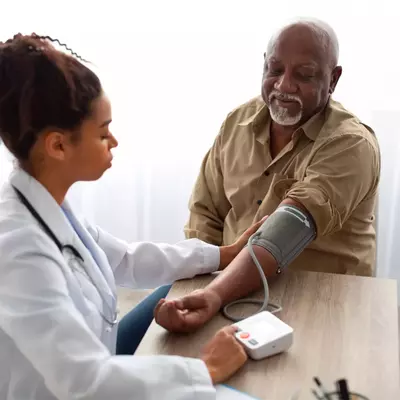- AdventHealth
If you've heard about glioblastomas recently, you might be wondering about this aggressive type of brain cancer. And as we extend a healing hand to patients and families affected by glioblastomas, it's also important to raise awareness about this type of cancer.
As a neuro-oncologist and neurologist at AdventHealth with 30 years of experience in treating brain and spinal cord tumors, Dr. Herbert Newton explains five things to know about glioblastoma.
1. Glioblastoma is a highly malignant form of brain cancer that spreads quickly within the brain.
Glial cells form the brains glue-like supportive tissue, and the most abundant glial cells in the brain are called astrocytes, named for their star-like shape. Astrocytes tile the central nervous system to help regulate the brains transmission of electrical impulses. They are closely connected to the brains dense network of blood vessels, which contributes to the aggressiveness of cancers that affect them.
Tumors arising from astrocytes are called astrocytomas, and glioblastomas are the most aggressive type (grade 4), explains Dr. Newton.
Glioblastomas are the most common malignant brain tumors found in adults over age 25, making up about two-thirds of astrocytomas, he adds.
And while glioblastomas are not common compared to other types of cancer, Dr. Newton states that as specialists in treating cancers that affect the brain, it is a common cancer that he and his team treats at the AdventHealth Cancer Institute.
Patients are beginning to travel to us for their glioblastoma treatment; we have seen up to three new cases a week, Dr. Newton notes. While we offer some of the latest treatments for glioblastoma, this cancer is very aggressive and no treatment is curative at this point in time.
2. Glioblastomas are often diagnosed after a quick onset of symptoms.
Glioblastoma is typically a very fast growing tumor, so symptoms tend to come on quickly and intensely and correlate to the part of the brain that the glioblastoma is affecting, advises Dr. Newton.
That said, he explains that a very common initial symptom is a fast onset of headaches that differ from your typical tension or migraine headache. Other symptoms can occur alone or in combination, and include:
- Balance issues
- Weakness on one side of the body
- Changes in memory or cognitive abilities
- Difficulties with speech or vocation
- Blurred vision
- Seizures
According to Dr. Newton, patients can experience atypical symptoms, such as blood clot that hemorrhages.
Patients generally present to the ER or their primary care physician with these symptoms, depending on how severe, and after diagnostic testing that includes an MRI, will get the formal diagnosis, advises Dr. Newton.
If glioblastoma is suspected, patients will then be referred to a neuro-oncologist such as Dr. Newton for further evaluation and treatment recommendations.
3. Although this form of cancer cannot be cured, treatments may improve the prognosis.
The worldwide standard of care for glioblastoma treatment includes a three-phased protocol, explains Dr. Newton.
1. Maximal surgical resection (removal of the tumor)
2. 6-week course of chemotherapy with temozolomide
3. Radiation therapy
Dr. Newton describes another FDA-approved glioblastoma treatment option offered to qualifying patients at the AdventHealth Cancer Institute, called Optune. This cap-like device creates low-intensity electric fields that could help slow or stop glioblastoma cancer cells from dividing, and may also cause some of them to die.
Dr. Newton explains that every patient's course of treatment is always customized considering a host of factors, including age, medical history, current health status and how well each patient tolerates treatments, which often becomes harder with advanced age.
And even for patients that do tolerate the treatments well, Glioblastoma is often challenging to treat because of the tumors:
- Heterogeneity (tumor cells that express and metastasize differently)
- Possible location in a region of the brain that's difficult to access, or too close to major blood vessels or speech or motor strip of the brain
- Tendency to reoccur rapidly and aggressively
Many of these are challenges are being studied through clinical trials. Gaining a better understanding why and how glioblastoma forms and progresses in the brain could lead to a cure.
There are clinical trials examining specific molecular therapies for glioblastomas that could bring more targeted treatments in the future, but this is still under study as a first line of treatment, says Dr. Newton.
4. The exact cause of glioblastomas is unknown.
Most glioblastomas are not inherited they usually occur sporadically in people with no family history of tumors, advises Dr. Newton.
He continues, They can rarely occur in people with certain genetic syndromes, but its more likely to see some families having a strong predilection to cancer in general.
5. While there is no cure, there is still hope.
Doctors like Dr. Newton at the AdventHealth Cancer Institute are always pushing the boundaries of medicine, learning of and implementing some of the latest treatment options and surgical techniques to improve the care of patients with glioblastoma and other types of brain tumors.
Dr. Newton is one of the Institutes very experienced neurological cancer specialists, who has turned his fascination for the brain to helping patients find hope, even in the most serious circumstances.
Dr. Newton concludes:
I was always interested in the brain and how cancer affects the nervous system, which is what drove me put these interests together with my career in neuro-oncology. In our field, it is our hope to make an impact. And while we sometimes must provide sad or disappointing news, we always strive to extend and improve quality of life while providing comfort to patients and their families.



